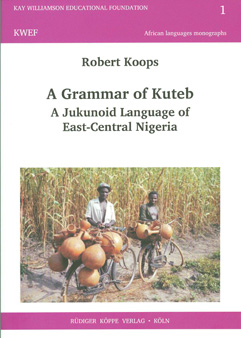


The Benue-Congo languages of Nigeria are spoken in the centre and east of the country, and probably number some 150 or so. They remain extremely poorly documented, from the point of view of both lexicon and grammar. The Jukunoid family, first outlined by Shimizu in 1980, comprises about 20 languages, spoken by approx. 350,000 people in north-east Nigeria, is currently represented only by a few grammars (f.i. Bezen, Jukun and Hone), see the link below.
This is a grammar of the Kuteb language, one of the southern group, so far almost undescribed, although Koelle included a wordlist in his Polyglotta Africana in 1854.
The Kuteb people number more than 100,000 and live mainly in what is now Takum Local Government Area of Taraba State, Nigeria. The grammar is introduced by a historical and ethnographic sketch of the region. Kuteb is divided into a number of dialects, some with strikingly distinctive phonologies and the grammar illustrates and discusses this variation.
An overview of the phonology also includes an outline of the standard Kuteb orthography. The remainder of the grammar covers morphology and syntax, based on numerous texts collected in the course of long-term fieldwork in the region. An extensive Kuteb narrative in an appendix illustrates many of the constructions described in the main text.
The text is a fully revised and updated version of Robert Koops’ thesis, “Aspects of Kuteb Grammar”, submitted in 1990 to the Linguistics Department of the University of Colorado (Boulder/CO, Advisor: Zygmunt Frajzyngier). It is expected that a dictionary will be prepared to complement the grammar in due course.
Sämtliche Beispielsätze sind mit einer übersichtlichen, interlinearen Übersetzung unterlegt; auch ungrammatische Satzbeispiele sind in dem Werk angeführt. Dies lässt auf Koops sorgfältige Expertise der Sprache schließen. Das westafrikanische Sprachgebiet zeichnet sich einerseits durch eine extrem spärliche wissenschaftliche Datenlage und andererseits durch eine bis heute andauernde Vernachlässigung seitens der westlichen Sprachwissenschaft aus. Koops ausführliche linguistische Beschreibung des Kuteb erscheint unter diesen Bedingungen als eine willkommene und lang ersehnte Bereicherung für die afrikanische Sprachforschung. [...] das vorliegende Werk wird seinen verdienten Platz in den Bibliotheken der historisch-vergleichenden Sprachwissenschaft, der Sprachtypologie und der Afrikawissenschaften finden.
Tamara Prischnegg in Orientalische Literaturzeitung, 106(2011), 4-5, 359-61
This rich and well-presented grammar can only be a first step towards the documentation of the grammatical and sociolinguistic complexity of Kuteb. It is an indispensable contribution to Benue-Congo linguistics and a fascinating source for all those interested in the outstanding linguistic diversity of West-Central Africa. Rob Koops has not only provided a comprehensive description of all domains of the grammar – phonology, morphology, morphosyntax, and syntax – of Kuteb, but also has raised a number of fascinating and challenging questions for future research. These include the reconstruction of noun classes, exploring sensual words such as smell terms and ideophones, and the study of verb semantics and transitivity. The present volume is to be recommended to Africanists specializing in Benue-Congo and/or linguistic areas in West-Central Africa, as well as to linguists who are interested in the relations between language, culture and cognition.
Anne Storch in Journal of African Languages and Linguistics, 33/1, 2012, 122-125
© 2026 by Rüdiger Köppe Verlag – www.koeppe.de